SPECIES DESCRIPTIONS AND THEIR USE IN AQUACULTURE
Groupers (class Actinopterygii, order Perciformes, family Serranidae, sub-family Epinephelinae) comprise 14 genera and 449 species of the subfamily Epinephelinae, or roughly half of all species in the family Serranidae (groupers and sea basses) (Heemstra and Randall, 1993). There are 16 major grouper species that are cultured; the dominant species vary somewhat regionally.
The most consistently abundant species that are captured for culture purposes and also reared in hatcheries are Epinephelus coioides and E. malabaricus. Other important species are E. bleekeri, E. akaara, E. awoara and E. areolatus. E. amblycephalus, E. fuscoguttatus, E. lanceolatus, E. sexfasciatus, E. trimaculatus, E. quoyanus, E. bruneus, Cromileptes altivelis, Plectropomus leopardus and P. maculatus are cultured in small amounts. In the southeastern United States of America and the Caribbean, E. striatus, E. itajara, Mycteroperca microlepis and M. bonaci seem to have good farming potential (Tucker, 1999). However, CBA for groupers in the western hemisphere has not been developed to any large extent, unlike in Southeast Asia.
Juveniles and adults of some grouper species live in coastal or lagoonal waters and estuaries, while others prefer the cleaner waters of offshore reefs. Their eggs are single, non-adhesive, and buoyant at normal salinities. The larvae of most species spend about 30–50 days as planktonic larvae (Colin, Koenig and Laroche, 1996). As they become juveniles, groupers settle in shallow waters where they seek shelter in seagrass beds, mangrove prop roots, coral rubble, branching coral or branching macroalgae. Some juvenile groupers are habitat generalists, settling in any available shelter, while other species have specific nursery habitats in which their growth and survival are enhanced (Tupper, 2007). After hatching, wild grouper larvae eat copepods and other small zooplankton. They switch to larger crustaceans, such as amphipods and mysid shrimp, as they grow. Wild juveniles and adults eat fish, crabs, shrimp, lobsters and molluscs (Tucker, 1999), although the genus Plectropomus tends to be predominantly piscivorous.
Groupers range in maximum size from only 12 cm (e.g. Paranthias colonus) to over 3 m (e.g. Epinephelus lanceolatus). Most groupers that have been studied are sexually mature within 2–6 years, but some of the larger species may take longer to mature, e.g. Epinephelus fuscoguttatus, which matures at about 9 years. Most serranids are protogynous hermaphrodites. As a rule, some change from female to male as they grow older; others may change only if there is a shortage of males. In nature, many species spawn in large aggregations (hundreds to thousands of fish) with a sex ratio nearing 1:1 (Rhodes and Sadovy, 2002). In some cases, several grouper species may share the same aggregation site (e.g. in Palau and Pohnpei; see Johannes et al., 1999; Rhodes and Tupper, 2007).
Groupers are some of the top predators on coral reefs, and tend to be K-strategists demonstrating slow growth, late reproduction, large size and long life-spans which make them vulnerable to overexploitation. Also contributing to their vulnerability is the fact that they are sex-changers with a low proportion of males in the smaller cohorts, which means that heavy fishing pressure often removes most of the males (or removes fish before they can become male). Additionally, many groupers form spawning aggregations that are predictable in space and time, making them extremely easy to harvest. These aggregations can represent the entire annual reproductive output for some species. Groupers are sedentary in character and strongly territorial, making them easy targets for spear fisheries (Bullock et al., 1992; Heemstra and Randall, 1993; Sadovy, 1996; Domeier and Colin, 1997; Sadovy and Eklund, 1999; Morris, Roberts and Hawkins, 2000). Tables 1–16 summarize the characteristics of grouper species most commonly encountered in CBA, while Figures 1–32 illustrate their appearance and geographical distribution.
Cromileptes altivelis (Valenciennes, 1828)
FIGURE 1
Humpback grouper (Cromileptes altivelis)
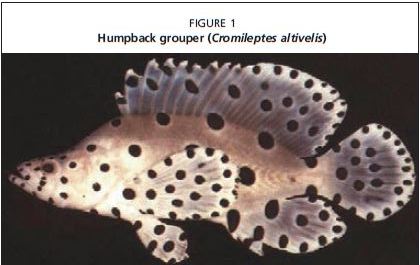
TABLE 1
Characteristics of the humpback grouper, Cromileptes altivelis
Common names: Humpback grouper, panther grouper, mouse grouper, highfin grouper Size and age: Max size 70.0 cm TL
Environment: Reef-associated; marine; depth range 2–40 m
Climate: Tropical; 32°N - 23°S, 88°E - 168°E
Importance: Juveniles are commonly caught for the aquarium trade while adults are utilized as a food fish. Very high value in China Hong Kong SAR live fish markets.
Resilience: Low, minimum population doubling time 4.5–14 years.
Biology and ecology: Generally inhabits lagoon and seaward reefs and are typically found in dead or silty areas. Also found around coral reefs and in tide pools. Growth is very slow. Feed on small fishes
and crustaceans.
Source: Modified from FishBase (Froese and Pauly, 2007).
FIGURE 2
Distribution of Cromileptes altivelis (FishBase, 2007)

Epinephelus akaara (Temminck and Schlegel, 1842)
FIGURE 3
Hong Kong grouper (Epinephelus akaara)

TABLE 2
Characteristics of the Hong Kong grouper, Epinephelus akaara
Common names: Hong Kong grouper
Size and age: 53.0 cm TL; max. published weight: 2 470 g
Environment: Reef-associated; marine
Climate: Tropical; 39°N - 20°N, 109°E - 143°E
Importance: A highly prized food fish in China Hong Kong SAR live fish markets. Resilience: Medium, minimum population doubling time 1.4–4.4 years.
Biology and ecology: Little is known about the biology and ecology of this species. Usually caught by hand-lining over rock strata. Listed as endangered by IUCN Grouper And Wrasse Specialist Group.
Source: Modified from FishBase (Froese and Pauly, 2007).
FIGURE 4
Distribution of Epinephelus akaara (FishBase, 2007)

Epinephelus amblycephalus (Bleeker 1857)
FIGURE 5
Banded grouper (Epinephelus amblycephalus)
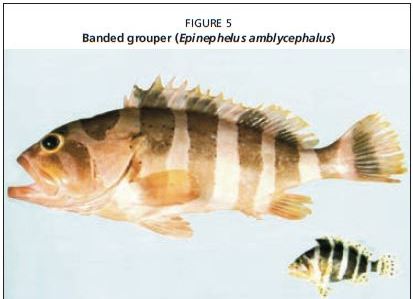
TABLE 3
Characteristics of the banded grouper, Epinephelus amblycephalus
Common names: Banded grouper
Size and age: 50.0 cm TL
Environment: Reef-associated; marine; depth range 80–130 m
Climate: Tropical; 35°N - 20°S, 95°E - 179°W
Importance: Fisheries: minor commercial.
Resilience: Medium, minimum population doubling time 1.4–4.4 years.
Biology and ecology: Little known.
Source: Modified from FishBase (Froese and Pauly, 2007).
FIGURE 6
Distribution of Epinephelus amblycephalus (FishBase, 2007)

Epinephelus areolatus (Forsskal, 1775)
FIGURE 7
Areolate grouper (Epinephelus areolatus)
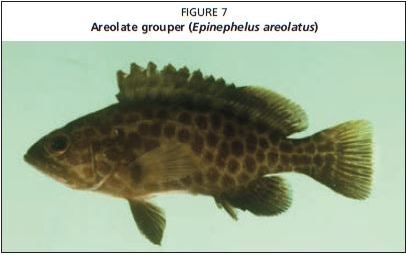
TABLE 4
Characteristics of the areolate grouper, Epinephelus areolatus
Common names: Areolate grouper
Size and age: 47.0 cm TL; max. published weight: 1 400 g; max. reported age: 15 years Environment: Reef-associated; marine; depth range 6–200 m
Climate: Tropical; 35°N - 33°S, 29°E - 180°E
Importance: An important fisheries and aquaculture species in the Live Reef Fish Trade (LRFT). Resilience: Medium, minimum population doubling time 1.4–4.4 years.
Biology and ecology: Usually found in seagrass beds or on fine sediment bottoms near rocky reefs, dead coral, or alcyonarians, in shallow continental shelf waters. Juveniles are common at water depths
to 80 m. Probably spawn during restricted periods and form aggregations when doing
so. Eggs and early larvae are probably pelagic. Feed on fish and benthic invertebrates,
primarily prawns and crabs.
Source: Modified from FishBase (Froese and Pauly, 2007).
FIGURE 8
Distribution of of Epinephelus areolatus (FishBase, 2007)

Epinephelus awoara (Temminck & Sclegel 1842)
FIGURE 9
Yellow grouper (Epinephelus awoara)

TABLE 5
Characteristics of the yellow grouper, Epinephelus awoara
Common names: Yellow grouper
Size and age: 60.0 cm TL
Environment: Reef-associated; marine; depth range 10–50 m
Climate: tropical; 39°N - 12°N, 110°E - 143°E
Importance: Commercial fisheries and aquaculture; medium value in China Hong Kong SAR live fish markets.
Resilience: High, minimum population doubling time less than 15 months (Fecundity = 24 329).
Biology and ecology: Occurs in rocky areas as well as on sandy-mud bottoms. Juveniles are common in tide pools. In captivity, the species is aggressive, chasing and biting other species, especially members
of its own species. Protogynous hermaphrodite. Artificial fertilization of eggs was done
and the longest survival time for the larvae was 15 days.
Source: Modified from FishBase (Froese and Pauly, 2007).
FIGURE 10
Distribution of Epinephelus awoara (FishBase, 2007)
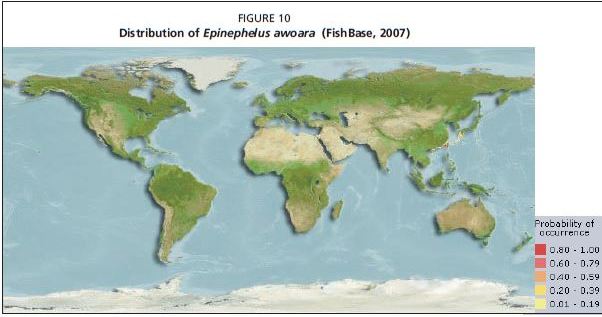
Epinephelus bleekeri (Temminck & Sclegel 1842)
FIGURE 11
Duskytail grouper (Epinephelus bleekeri)
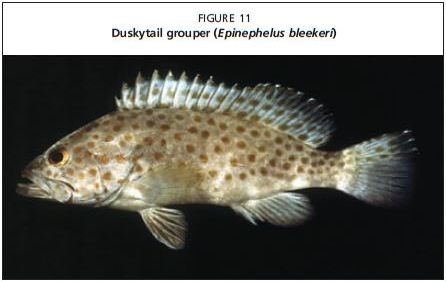
TABLE 6
Characteristics of the duskytail grouper, Epinephelus bleekeri
Common names: Duskytail grouper
Size and age: 76.0 cm TL
Environment: Demersal; marine; depth range 30–104 m
Climate: Tropical; 32°N - 17°S, 48°E - 136°E
Importance: Minor commercial fisheries value, moderate commercial aquaculture value. In China Hong Kong SAR live fish markets.
Resilience: Low, minimum population doubling time 4.5–14 years (t max=24).
Biology and ecology: Occurs on shallow banks, but is not known from well-developed coral reefs. Usually taken by trawling in 30–45 m or by hand-lining over rocky banks.
Source: Modified from FishBase (Froese and Pauly, 2007).
FIGURE 12
Distribution of Epinephelus bleekeri (FishBase, 2007)
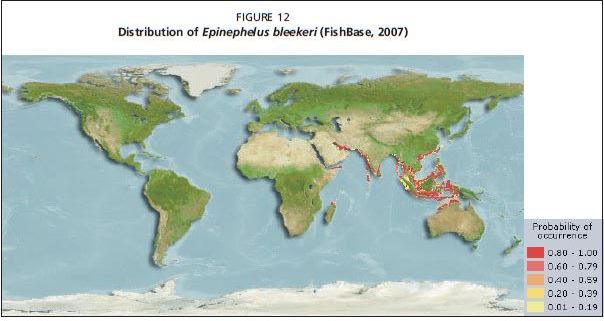
Epinephelus bruneus (Bloch, 1793)
FIGURE 13
Longtooth grouper (Epinephelus bruneus)

TABLE 7
Characteristics of the longtooth grouper, Epinephelus bruneus
Common names: Longtooth grouper
Size and age: 128 cm TL (male/unsexed; Ref. 40637); max. published weight: 33.0 kg (Ref. 40637) Environment: Reef-associated; marine; depth range 20–200 m
Climate: Tropical; 38°N - 17°N, 108°E - 142°E
Importance: Important in commercial and recreational fisheries. Commercially cultured in Japan and China Hong Kong SAR.
Resilience: Very low, minimum population doubling time more than 14 years. Biology and ecology: Inhabits rocky reefs; also found on muddy grounds. Juveniles occur in shallow waters.
Source: Modified from FishBase (Froese and Pauly, 2007).
FIGURE 14
Distribution of Epinephelus bruneus (FishBase, 2007)

Epinephelus coioides (Hamilton, 1822)
FIGURE 15
Orange-spotted grouper (Epinephelus coioides)
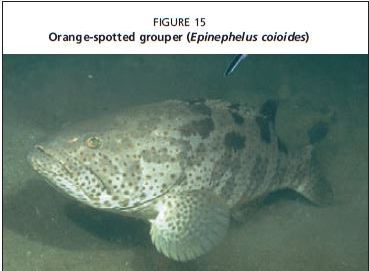
TABLE 8
Characteristics of the orange-spotted grouper, Epinephelus coioides
Common names: Orange-spotted grouper, estuary grouper, green grouper
Size and age: 120 cm TL (male/unsexed; Ref. 47613); max. published weight: 15.0 kg (Ref. 11228); max. reported age: 22 years
Environment: Reef-associated; brackish; marine; depth range 2–100 m
Climate: Subtropical; 37°N - 34°S, 28°E - 180°E
Importance: Important for commercial fisheries and aquaculture throughout Southeast Asia; major species in China Hong Kong SAR live fish markets.
Resilience: Medium, minimum population doubling time 1.4–4.4 years (K=0.17; tmax=22).
Biology and ecology: Inhabit turbid coastal reefs and are often found in brackish water over mud and rubble. Juveniles are common in shallow waters of estuaries over sand, mud and gravel and among
mangroves. Feed on small fishes, shrimps, and crabs. Probably spawn during restricted
periods and form aggregations when doing so. Eggs and early larvae are probably pelagic.
Source: Modified from FishBase (Froese and Pauly, 2007).
FIGURE 16
Distribution of Epinephelus coioides (FishBase, 2007)
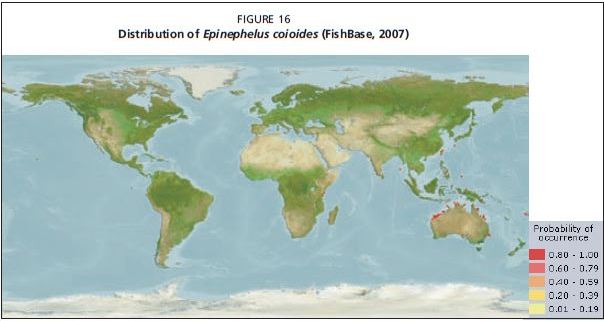
Epinephelus fuscoguttatus (Forsskal, 1775)
FIGURE 17
Brown-marbled grouper (Epinephelus fuscoguttatus)

TABLE 9
Characteristics of the brown-marbled grouper, Epinephelus fuscoguttatus
Common names: Brown-marbled grouper, tiger grouper, dusky grouper, flowery grouper, flowery cod Size and age: 120 cm TL; max weight 35.0 kg, max. age >40 years
Environment: Reef-associated; marine; depth range 1–60 m
Climate: Tropical; 35°N - 27°S, 39°E - 171°W
Importance: Minor commercial fisheries, moderate importance in aquaculture and live reef fish trade. Cultured in Singapore, Philippines and Indonesia.
Resilience: Medium, minimum population doubling time 1.4–4.4 years (K=0.16-0.20).
Biology and ecology: Occurs in lagoon pinnacles, channels, and outer reef slopes, in coral-rich areas and with clear waters. Juveniles in seagrass beds. Feeds on fishes, crabs, and cephalopods. May be
ciguatoxic in some areas. Mainly active at dusk.
Source: Modified from FishBase (Froese and Pauly, 2007).
FIGURE 18
Distribution of Epinephelus fuscoguttatus (FishBase, 2007)
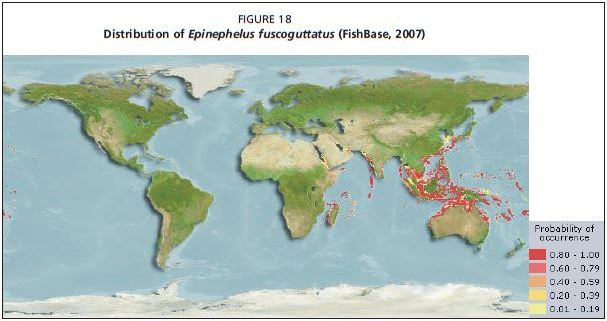
Epinephelus lanceolatus (Bloch, 1790)
FIGURE 19
Giant grouper (Epinephelus lanceolatus)
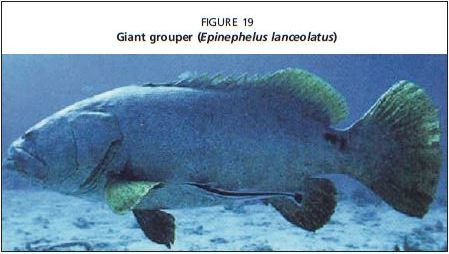
TABLE 10
Characteristics of the giant grouper, Epinephelus lanceolatus
Common names: Giant grouper, Queensland grouper
Size and age: 270 cm TL; max. published weight: 455.0 kg
Environment: Reef-associated; brackish; marine; depth range 1–100 m
Climate: Tropical; 28°N - 39°S, 24°E - 122°W
Importance: Important in subsistence fisheries, commercial aquaculture, recreational gamefish. Cultured in Taiwan PC. In live reef fish markets. Juveniles sold in ornamental trade as “bumblebee
grouper”.
Resilience: Very low, minimum population doubling time more than 14 years.
Biology and ecology: The largest bony fish found in coral reefs. Common in shallow waters. Found in caves or wrecks; also in estuaries, from shore and in harbours. Juveniles secretive in reefs and rarely
seen. Feeds on spiny lobsters, fishes, including small sharks and batoids, and juvenile sea
turtles and crustaceans. Nearly wiped out in heavily fished areas. Large individuals may be
ciguatoxic.
Source: Modified from FishBase (Froese and Pauly, 2007).
FIGURE 20
Distribution of Epinephelus lanceolatus (FishBase, 2007) 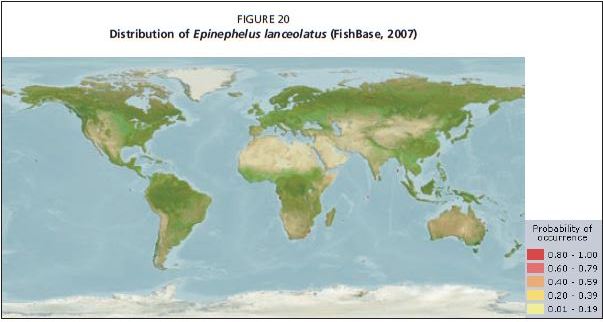
Epinephelus malabaricus (Bloch and Schneider, 1801)
FIGURE 21
Malabar grouper (Epinephelus malabaricus)
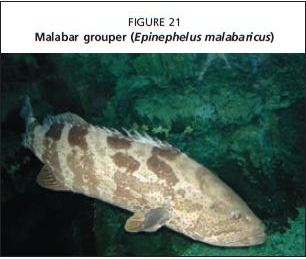
TABLE 11
Characteristics of the Malabar grouper, Epinephelus malabaricus
Common names: Malabar grouper, estuary grouper, green grouper
Size and age: 234 cm TL; max. published weight: 150.0 kg
Environment: Reef-associated; amphidromous; brackish; marine; depth range 0–150 m Climate: Tropical; 30°N - 32°S, 29°E - 173°W
Importance: High value commercial and recreational fisheries and aquaculture. Cultured throughout Asia. Along with E. coioides, the most common species in live reef fish markets.
Resilience: Very low, minimum population doubling time more than 14 years. Listed as Near Threatened (NT) by the IUCN Grouper and Wrasse Specialist Group.
Biology and ecology: A common species found in a variety of habitats: coral and rocky reefs, tide pools, estuaries, mangrove swamps and sandy or mud bottom from shore to depths of 150 m.
Juveniles found near shore and in estuaries; sex reversal probable. Feeds primarily on fishes
and crustaceans, and occasionally on cephalopods.
Source: Modified from FishBase (Froese and Pauly, 2007).
FIGURE 22
Distribution of Epinephelus malabaricus (FishBase, 2007)
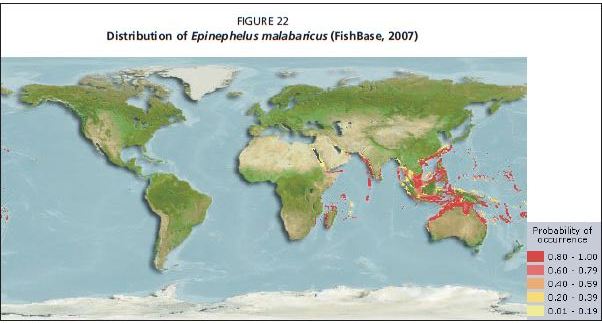
Epinephelus quoyanus (Valenciennes, 1830)
FIGURE 23
Longfin grouper (Epinephelus quoyanus)

TABLE 12
Characteristics of the longfin grouper, Epinephelus quoyanus
Common names: Longfin grouper
Size and age: 40.0 cm TL
Environment: Reef-associated; marine; depth range 0–50 m
Climate: Tropical; 35°N - 32°S, 110°E - 156°E
Importance: Commercial fisheries and minor aquaculture; in China Hong Kong SAR live fish markets. Resilience: Medium, minimum population doubling time 1.4–4.4 years.
Biology and ecology: Inhabits inshore silty reefs; there are no records from depths greater than 50 m. Feeds on crustaceans, fishes, and worms. The enlarged fleshy pectoral fins appear to have resulted
from its habit of sitting on the substrate.
Source: Modified from FishBase (Froese and Pauly, 2007).
FIGURE 24
Distribution of Epinephelus quoyanus (FishBase, 2007)
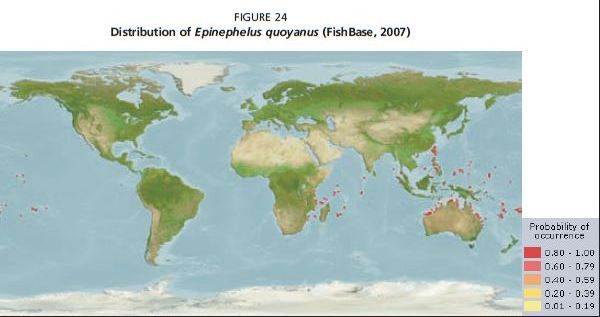
Capture-based aquaculture of groupers 233 Epinephelus sexfasciatus (Valenciennes, 1828)
FIGURE 25
Sixbar grouper (Epinephelus sexfasciatus)
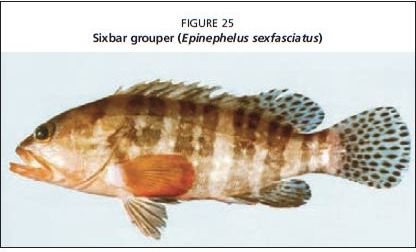
TABLE 13
Characteristics of the sixbar grouper, Epinephelus sexfasciatus
Common names: Sixbar grouper, six-banded grouper
Size and age: 40.0 cm TL
Environment: Reef-associated; marine; depth range 10–80 m
Climate: Tropical; 21°N - 21°S, 94°E - 143°E
Importance: Fisheries: commercial.
Resilience: Medium, minimum population doubling time 1.4–4.4 years (K=0.16).
Biology and ecology: Common on silty sand or mud bottoms. Its preference for soft-bottom habitats may account for its restricted distribution and absence at oceanic islands. Feeds on small fishes
and crustaceans.
Source: Modified from FishBase (Froese and Pauly, 2007).
FIGURE 26
Distribution of Epinephelus sexfasciatus (FishBase, 2007)
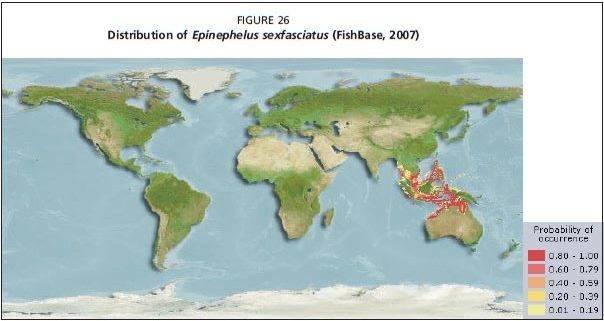
Epinephelus trimaculatus (Valenciennes, 1828)
FIGURE 27
Threespot grouper (Epinephelus trimaculatus)
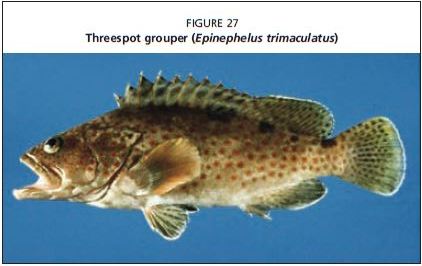
TABLE 14
Characteristics of the threespot grouper, Epinephelus trimaculatus
Common names: Threespot grouper
Size and age: 40.0 cm SL
Environment: Reef-associated; marine
Climate: Tropical; 37°N - 20°N, 112°E - 143°E
Importance: Commercial fisheries and minor aquaculture. In China Hong Kong SAR live fish markets. Resilience: Medium, minimum population doubling time 1.4–4.4 years.
Biology and ecology: Juveniles are common in tide pools and in shallow clear water around rocks and coral reefs; adults found in deeper water.
Source: Modified from FishBase (Froese and Pauly, 2007).
FIGURE 28
Distribution of Epinephelus trimaculatus (FishBase, 2007)
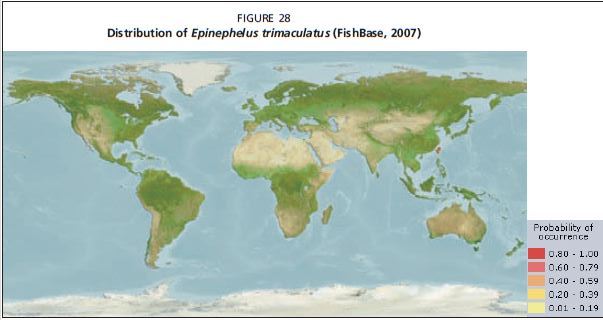
Plectropomus leopardus (Lacepede, 1802)
FIGURE 29
Leopard coralgrouper (Plectropomus leopardus)
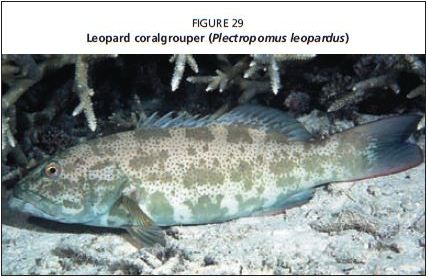
TABLE 15
Characteristics of the leopard coralgrouper, Plectropomus leopardus
Common names: Leopard coralgrouper, coral trout
Size and age: 120 cm SL; max. published weight: 23.6 kg; max. reported age: 26 years. On the Great Barrier Reef, lifespan is 14 years.
Environment: Reef-associated; marine; depth range 3–100 m
Climate: Tropical; 24; 35°N - 30°S, 106°E - 178°W
Importance: Commercial and recreational fisheries and aquaculture, juveniles in ornamental trade.
Resilience: Medium, minimum population doubling time 1.4–4.4 years (tm = 2–4; tmax = 26; Fecundity = 457 900). Listed as Near Threatened by IUCN Grouper and Wrasse Specialist Group.
Biology and ecology: Inhabit coral-rich areas of lagoon reefs and mid-shelf reefs. Juveniles in shallow water in reef habitats, especially around coral rubble. Adults piscivorous. Juveniles feed on small fish
and invertebrates such as crustaceans and squid. A protogynous hermaphrodite forming
spawning aggregations on a reef around the new moon.
Source: Modified from FishBase (Froese and Pauly, 2007).
FIGURE 30
Distribution of Plectropomus leopardus (FishBase, 2007) 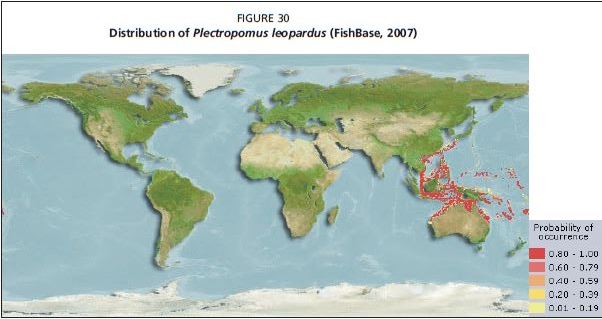
Plectropomus maculatus (Bloch, 1790)
FIGURE 31
Spotted coral grouper (Plectropomus maculatus)
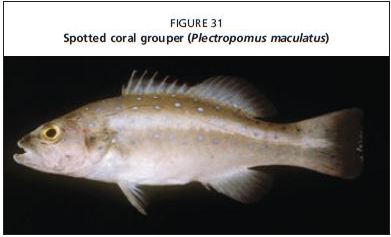
TABLE 16
Characteristics of the spotted coralgrouper, Plectropomus maculatus
Common names: Spotted coral grouper, spotted coral trout
Size and age: 100.0 cm SL; max. published weight: 25.0 kg
Environment: Reef-associated; marine; depth range 5–100 m
Climate: Tropical; 21°N - 28°S, 117°E - 159°E
Importance: Commercial and recreational fisheries and aquaculture. In China Hong Kong SAR live fish markets. Commonly used for food. Its flesh is delicate and well appreciated.
Resilience: Medium, minimum population doubling time 1.4–4.4 years (K=0.21; tm=2–3).
Biology and ecology: Found in protected coastal reef in mixed algae and coral habitat Common on inshore coastal reefs but absent in clear offshore reefs. Juveniles in shallow water in reef
habitats, especially around coral rubble. Migrate over short distances to spawn, forming
aggregations.
Source: Modified from FishBase (Froese and Pauly, 2007).
FIGURE 32
Distribution of Plectropomus maculatus (FishBase, 2007)
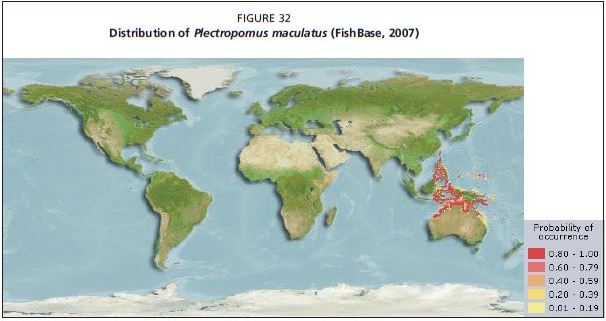
Trends in production of cultured grouper
Groupers are cultured in many Southeast Asian countries, including Indonesia, Malaysia, Philippines, Taiwan Province of China, Thailand, China Hong Kong SAR, the southeast of China and Viet Nam (Sadovy, 2000). Grouper culture is also undertaken in India, Sri Lanka, Kingdom of Saudi Arabia, Republic of Korea, Australia, the Caribbean as well as in the southeastern United States of America.
Despite the huge popularity of live fish in China and Southeast Asia, only 15–20 percent of the amount consumed each year comes from aquaculture, as culture is principally constrained by limited and unreliable supplies of wild seed and the difficulties of spawning in captivity. However, hatchery production has increased in recent years (e.g. Taiwan Province of China and Kuwait) (Tucker, 1999). It is difficult to get accurate statistics on farmed grouper production because statistics do not differentiate between those simply being caught from natural sources and held for a few weeks in cages before being sold, and those cultured for a longer period of time (Ottolenghi et al., 2004).
Grouper production through aquaculture is mainly reported by countries in Asia, where over 9 300 tonnes were produced in 2000. The actual figures of grouper production in Southeast Asia are reported by Sadovy (2000) to be far higher, at 23 000 tonnes; however, about 20 percent of this production may be based on hatchery produced fry, while the remainder is from wild seed. Kongkeo and Phillips (2002) estimated Asian production to be around 15 000 tonnes. In each case, these figures are significantly higher than the official statistics published by FAO. According to official statistics, Taiwan Province of China was the leading producer, with nearly 5 100 tonnes (54 percent of the global total). A total of 7 200 tonnes was produced in brackish water in Taiwan Province of China, Malaysia and Thailand. The remaining production was from mariculture a total of 2 100 tonnes, mainly in Indonesia, China Hong Kong SAR and Taiwan Province of China.
Grouper culture systems
There are many different systems used for the culture of groupers worldwide, although there seems to be an agreed set of stages: nursery, transition, and on-growing (Ottolenghi et al., 2004). Grouper seed must be nursed before being cultured to marketable size. The nursery stage is reared either in tanks, net cages and hapas (nylon netting enclosures), or in earthen ponds. Grading is a prerequisite to minimize cannibalism, especially in the nursery and early grow-out stages. After nurseries, there are two main systems used for on-growing: pond culture or cage culture. The stocking density and rearing conditions in both nursery and grow-out phases vary, depending on the site, the fish sizes, and the grouper species cultured.
Wild fry (2.5–7.2 cm) or fingerlings (7.5–12 cm) may initially be held in tanks or net cages or earthen ponds for a month or more (nursing period) after harvest (Ottolenghi et al., 2004). The density may range from 100 to 150 fish/m2, e.g. a net of 2 x 2 x 2 m would hold 400–600 fingerlings. Sorting is undertaken weekly and stock sampling every 2 weeks. Groupers are normally retained in the nursery until they reach about 16 cm, when they are thinned out and transferred to transition nets (5 x 5 x 5 m) that each hold 1 100 fish. The fish are finally transferred to production nets after 2–3 months. Floating cages are often constructed from bamboo poles and polyethylene netting material (25–50 mm mesh size). Net cages are formed by two types of panels: 4 side panels forming the walls, and one bottom panel. The net is secured to the raft structure (bamboo poles) by ropes. Ropes are also used to lash the bamboo poles together. Buoyancy is provided by empty plastic containers attached to the bamboo frames (www.seafdeec.org.ph). Net cages come in several sizes (3 x 3 x 2.5 m; 4 x 4 x 2.5 m; 10 x 10 x 3 m); the mesh size ranges from 10 to 35 mm (Agbayani, 2002). The optimum stocking density averages 120 fish/m3. Growth to marketable size (600–800 g) takes approximately 8 months, with survival rates of 50 percent or less. Groupers can grow to 600 g in 12 months, to 1 kg within 18 months, and to 2 kg within 24 months (Tucker, 1999).
Harvesting of groupers is relatively simple (Ottolenghi et al., 2004). Selective harvesting of groupers weighing 400–600 g is best. A drag net is placed at the farthest end of the pond or cage, and dragged slowly towards the other end in the early morning. Fish are then transferred to a holding net where grading is carried out; undersized fish are returned to the pond or cage.